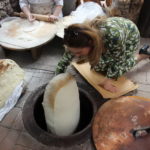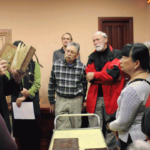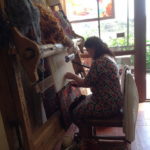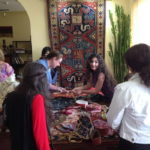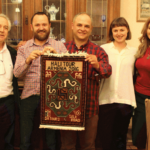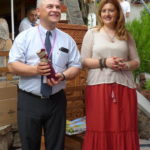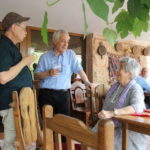HALI TOUR TO ARMENIA
After Ben Evans’ frst visit to Armenia to attend a carpet conference in 2013 (HALI 179, pp. 92-103), he recognized the potential of drawing the attention of a wider audience to the importance and variety of textiles there by taking HALI Tours to the region. Thirteen guests joined the frst of these in Yerevan in September 2015 for a round trip of some 600 miles, also crossing into neighboring Georgia for a day. This consolidated and enriched our understanding of Armenia and Georgia as nations with complex histories, rich weaving traditions and populations long involved in the production and trade of textiles. So we returned a second time with a slightly larger group, a slightly longer tour and more time scheduled in the tantalizing Georgian capital Tbilisi, where nineteen guests assembled on 7 May 2016.
At Haghpat Monastery and Noratus Cemetary, khachkar stones carry exquisitely carved winged crosses with elaborate knotted designs like those in illuminated manuscripts at the Matenadaran in Yerevan. Research conducted at this rich repository is supporting a revival and exploration of cultural heritage as seen at Lake Sevan where Cilicia, a well-journeyed replica of a 13th-century merchant sailing vessel is currently docked, and at a spellbinding performance on old-style instruments by the Traditional Armenian Music Ensemble. We were privileged to have special access to view precious fragments of early Indian and Sasanian textiles used in medieval book bindings that attest to Armenia’s pivotal position along the historic Silk Route. These were revealed by Professor Levon Choogaszian, who later delivered a lecture on early Armenian textiles depicted in manuscripts and contemporary works.
Special thanks must be directed to Tatev Muradyan for her ongoing assistance. She is curator at the Folk Art Museum the museum and manager of the Silk Road Hotel and Folk Arts Hub in Yerevan, where fresh tonir-baked lavash was served at a generous farewell lunch, sponsored by the hotel’s US-based owner Levon der Bedrossian and the Armenian Rug Society. Her enthusiasm and dedication to promoting textiles and cultural heritage with integrity are shared by HALI.
During the tour it became clear that while many of the most sought-after Caucasian rugs have now left the lands of their origin, many other notable and little-known textiles that share design elements with those carpets do remain in Armenia and Georgia; countries where rugs and textile traditions
continue to be considered a vital element of the national identity. Although Mount Ararat stayed concealed behind stubborn cloud for the duration the 2016 tour, many guests agreed that this provided a welcome motive to schedule a return to view the dramatic Yerevan skyline on another, clearer day.
Source: http://www.hali.com/
tours/photo-album-armenia-georgia-may-2016/
In this video from 3:50 minute you can watch an interview with my dearest colleague Mr. Ben Evans about the HALI Tour Armenia.
- in Silk Road Hotel
- in Sevan Like
- In Sevan Like
- In matenadaran
- in Silk Road Hotel
- in Silk Road Hotel
- in Silk Road Hotel
- in Silk Road Hotel
- in Silk Road Hotel
- in Silk Road Hotel


 Հայերեն
Հայերեն
